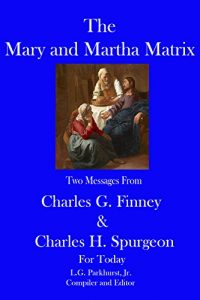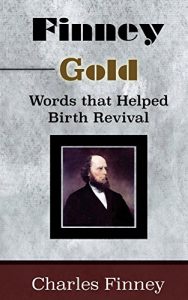The sixth book in the "Finney and Spurgeon Face to Face" series is "The Mary and Martha Matrix," where the messages of Charles G. Finney and Charles H. Spurgeon come face to face. In "The Mary and Martha Matrix," Mary sat at Jesus’ feet to listen to Him teach and then Martha came and asked Jesus to tell her sister to help her prepare the meal for their guests, which led to Jesus teaching both of them what was really important. In "The Mary and Martha Matrix," Finney and Spurgeon agree on the importance of listening to Jesus’ words. From them, you will learn why it was important to Jesus for both Mary and Martha to listen to Him teach, and why it was especially important to Mary at that time in her life and also important for Martha to listen to Him. Jesus often healed and taught people without stopping for a meal, and He could easily feed more than 5,000 people using a little boy’s lunch. He was more concerned about feeding people spiritually than everyone eating physically, and if everyone listened to Him spiritually, He could easily feed everyone physically when the time arrived. Martha did not need to give up the good part of the day with Jesus teaching in her home to prepare meals for His eager listeners. In "The Mary and Martha Matrix," you will learn especially from Spurgeon what must be an integral part of listening to Jesus for your listening to be effective. Each preacher offers insights that the other does not teach, and each of their messages offers food for thought and truths that can be taught to others. In another sense, Spurgeon seems to expand on the truths that Finney taught, while adding many of his own Spirit-inspired thoughts and applications. The sermon by Finney should be read first, as presented in "The Mary and Martha Matrix." Spurgeon will teach you much more about Martha than Finney taught, and he will also help you with the situation's application for today.
The seventh book in the series is "How All Things Work," based on Romans 8:28.
Without question among Nineteenth Century preachers and revivalists, Finney was America’s greatest revivalist and Spurgeon was England’s greatest preacher. Finney was trained to be a lawyer, and he served as a professor of theology and wrote a systematic theology; this background came through in his preaching. In his sermons, Spurgeon had the ability to draw graphic word pictures in a time before television and movies, and that God-given gift made him especially effective in leading people to trust in Christ alone and in meeting their spiritual needs from the Bible. Both men led thousands to faith in Jesus Christ during their lifetimes, and both men influence students of the Bible, and Christian preachers, revivalists, and theologians today. These two great Bible expositors can be studied together by reading their sermons on the same Biblical themes. Often contrasted in secondary sources, with the books in the "Finney and Spurgeon Face to Face" series readers can compare as well as contrast these men by reading what they actually taught.
Charles Grandison Finney [1792-1875] has been considered America’s Greatest Revivalist. He also served as theological professor and president of Oberlin College, Oberlin, Ohio, which he helped found in 1833. In 1980, L.G. Parkhurst began publishing the works of Charles Finney, beginning with "Principles of Prayer," through Bethany House Publishers. More recently he has published Finney’s works through Agion Press, beginning with all of his sermons on Paul’s Letter to the Romans in three volumes, "Principles of Righteousness," "Principles of Peace," and "Principles of Joy in the Holy Spirit."
Charles Haddon Spurgeon [1834-1892] has been considered the Prince of Preachers. He founded Spurgeon’s College in 1856 in London, England, which was named after him following his death. In 1988, L.G. Parkhurst published "The Believer’s Secret on Intercession," a devotional from the writings of Andrew Murray and C.H. Spurgeon.
The seventh book in the series is "How All Things Work," based on Romans 8:28.
Without question among Nineteenth Century preachers and revivalists, Finney was America’s greatest revivalist and Spurgeon was England’s greatest preacher. Finney was trained to be a lawyer, and he served as a professor of theology and wrote a systematic theology; this background came through in his preaching. In his sermons, Spurgeon had the ability to draw graphic word pictures in a time before television and movies, and that God-given gift made him especially effective in leading people to trust in Christ alone and in meeting their spiritual needs from the Bible. Both men led thousands to faith in Jesus Christ during their lifetimes, and both men influence students of the Bible, and Christian preachers, revivalists, and theologians today. These two great Bible expositors can be studied together by reading their sermons on the same Biblical themes. Often contrasted in secondary sources, with the books in the "Finney and Spurgeon Face to Face" series readers can compare as well as contrast these men by reading what they actually taught.
Charles Grandison Finney [1792-1875] has been considered America’s Greatest Revivalist. He also served as theological professor and president of Oberlin College, Oberlin, Ohio, which he helped found in 1833. In 1980, L.G. Parkhurst began publishing the works of Charles Finney, beginning with "Principles of Prayer," through Bethany House Publishers. More recently he has published Finney’s works through Agion Press, beginning with all of his sermons on Paul’s Letter to the Romans in three volumes, "Principles of Righteousness," "Principles of Peace," and "Principles of Joy in the Holy Spirit."
Charles Haddon Spurgeon [1834-1892] has been considered the Prince of Preachers. He founded Spurgeon’s College in 1856 in London, England, which was named after him following his death. In 1988, L.G. Parkhurst published "The Believer’s Secret on Intercession," a devotional from the writings of Andrew Murray and C.H. Spurgeon.












